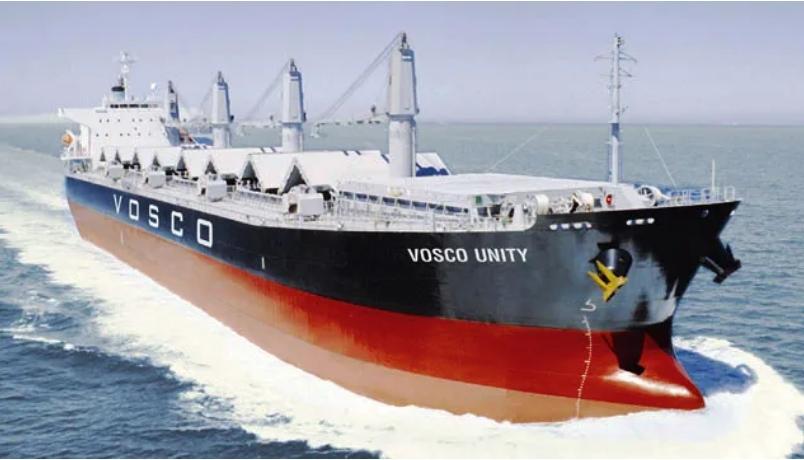《装卸时间与滞期费》第6版
CHAPTER 3 第3章
Commencement of laytime 装卸时间的起算
3.300 The point is made even more clearly in the speech of Lord Diplock where he analysed the adventure contemplated by a voyage charterparty into four stages. These were the approach voyage (which he referred to as the loading voyage), the loading operation, the carrying voyage and the discharge of the cargo. As he made clear, these stages are consecutive and cannot overlap. Arrival at the specified destination is the point both geographically and in time when the voyage stages end and the loading/discharging operations begin. Lord Diplock continued:
Since the business purpose of the voyage stages is to bring the vessel to a berth at which the cargo can be loaded or discharged, the shipowner does not complete the loading or the carrying voyage until the vessel has come to a stop at a place within the larger area whence her proceeding further would serve no business purpose. If on her arrival within the dock or port, there is a berth available at which the charterer is willing and able to load or discharge the cargo, the vessel must proceed straight there and her loading or carrying voyage will not be completed until she reaches it. But if no berth is available the voyage stage ends when she is moored at any convenient place from which she can get to a berth as soon as one is vacant.
This last sentence makes it clear what Lord Reid meant when he referred to the vessel having ‘‘reached a position within the port where she is at the immediate and effective disposition of the charterer’’ and Viscount Dilhorne when he said ‘‘she must have ended her voyage at the port named’’ if no berth is immediately available. There is also support for this proposition in The Maratha Envoy, where Lord Diplock quoted with approval from the judgment of Donaldson J at first instance:
He applied the Reid test from The Johanna Oldendorff. ‘‘The essential feature’’, he said [1975] 1 WLR 1372, 1378 is that the voyage shall have ended and the vessel be waiting.
3.300就这一点,Diplock勋爵在他的判决言论中已经讲的非常明白,他把航次租船合同预计的航程分为四个阶段。它们是预备航程(他指的也是装货航程)、装货作业、运送/载货航程和卸货作业。他明确表示,这些阶段是连续的而且不能重叠。抵达指定的目的地是航程阶段在地理上和时间上的结束点,尔后装/卸货作业开始。Diplock继续又说:
由于航程阶段的商业宗旨是使船舶靠泊能够进行装/卸货作业的泊位,直到船舶抵达某一比较大的范围区域内一个停靠地点(由此处,她若再往前继续航行就不会有什么商业意义),否则船东是无法装货或者进行下一阶段的运送航程。如果在她抵达码头或者港口内,承租人希望或能够进行装/卸货的泊位空闲可用,船舶必须直接前往此处,而且只有她抵达泊位,装货航程或者载货航程才能结束。但,如果没有泊位空闲可用,只有她在任何某一便利的位置系泊,并且一旦有泊位空出时,她能够从此处立即到达泊位,这时航程才算结束。
这最后一句话阐明了Reid勋爵所意指的‘船舶抵达港内某一位置并处于承租人立即马上和有效的支配之下’和Dihorne子爵所说的‘如果没有立即马上可用的泊位,她也必须是已经结束航程并抵达指定的港口’。这也是The Maratha Envoy案中的观点支持的理由,在该案,Diplock引用并赞同Donaldson法官在一审的判决词。
他(Diplock)在该案(The Maratha Envoy)适用了The Johanna Oldendorff案中的‘Reid准则’。‘根本的特征’是航程本应该已经结束而且船舶必须等待。
3.301 It is an essential feature of the division of the charterparty into the four stages that there is a clear division between the voyage stages and the loading/discharging operations. The voyage stages do not come to an end until the vessel is moored, i.e. anchored, or if the vessel can proceed directly, is alongside in the designated berth.
3.301把租船合同划分成4个阶段的一个基本特征是在航程阶段与装卸货作业之间有了明确的分工。直到船舶系泊,例如抛锚,或者,如果可以直接驶入靠泊在指定的泊位时,航程阶段才算结束。
3.302 It follows that at common law, notice of readiness cannot normally be given whilst the vessel is underway whether the vessel be making way or temporarily stopped in the water.
3.302由此可见,在普通法下,准备就绪通知书通常是不能在航行之中递交的,无论船舶是对水运动或者暂时停航。
3.303 However, does the wording of clause 6 supersede what the position would be at common law? There appear to be two possible approaches to what meaning should be given to this clause. The first is to say that there should be an implied term in the opening line of the clause so that it reads:
Upon arrival at customary anchorage or in berth (as hereinafter defined) if proceeding direct to berth...
and then apply the common law principles that the vessel does not reach her specified destination and therefore arrive until she either reaches a place ‘‘whence proceeding further would serve no business purpose’’, i.e. she anchors, or she arrives in berth.
3.303然而,第6条款的措辞是否取代在普通法里的地位?应当赋予该条款什么含义,似乎有两种可能的观点。第一种说,在该条款的空白之处,应当存在有默示条文并解释如下:
一旦抵达习惯性锚地或泊位(如下规定),如果直接前往泊位靠泊的话……
那么,船舶不能抵达她指定的目的地,所以直到她抵达另一个地方(由此处,她若再往前继续航行就不会有什么商业意义)才算抵达,例如去抛锚,或者抵达等待泊位,就适用普通法原则。
3.304 The alternative, and, it is suggested, less satisfactory, solution is to give a wider meaning to the words ‘‘upon arrival’’ and allow notice of readiness to be given at some point before the vessel comes to a stop by anchoring or berthing. However, this of itself would raise all sorts of practical problems. Must the ship pause, e.g. to pick up a pilot?; would an investigation have to be undertaken as to the anchorage limits?; what if there is more than one anchorage?; what if the vessel does not pass through any of the anchorages but proceeds directly to berth?
3.304另一种解决的方法,但这认为是不太满意的,是赋予‘一旦抵达’这些词语更广泛的含义并允许船舶在到达某一临时停靠点,例如抛锚或者靠泊之前的某些时间点递交准备就绪通知书。然而,这本身也会产生各种各样的实际问题。船舶必须暂时停止吗,例如,接领航员上船?是否要必须调查锚地边界?如果有超过一个锚地又如何?如果船舶并没有经过任何的锚地而是直接前往泊位靠泊又如何?
3.305 One case that illustrates the sort of problems dealt with in the preceding paragraphs is London Arbitration 12/06. In this case, the ship in question was due to load at Ras Tanura. She gave notice of readiness at the entry buoy at Ras Tanura, which is some distance from either of the two anchorages at which she might have been (and was in fact) ordered to wait for a berth. The charterers challenged the validity of the notice not on the basis that it was given whilst underway and therefore before the end of the voyage (see para. 3.49), although the report of the case does not refer to her anchoring or even pausing at the point when notice was given, but because clause 6 of Part II of the Asbatankvoy charter requires notice to be given “upon arrival at customary anchorage”. Nevertheless, the tribunal was prepared to and did hold that notice given at the entry buoy was valid.
3.305在报道的伦敦仲裁中,2006年第12号案,就对上一段内讨论的这类问题进行了阐述。在该案,有关船舶被指示到沙特Ras Tanura装货。她在Ras Tanura进口浮标处递交了准备就绪通知书,这离两个锚地中的任何一个她本应该(事实也是如此)被指示等待的锚地都有一段距离。承租人质疑通知书的有效性,他不是依据船舶在航行中和在结束航程之前递交的(参看第3.49段),虽然该案的报告并没有提到锚泊,或者,甚至是在递交通知书时那一地点短暂停航,而是因为Asbatankvoy租船合同第2部分第6条款规定‘在抵达习惯性锚地时’要求递交通知书。不过,法庭准备并且也确实是判决在进口浮标处递交的通知书是有效的。
3.306 Similarly in London Arbitration 21/07 the tribunal were willing to give a wide interpretation of where a customary anchorage was for the purposes of clause 6 of Part II of the Asbatankvoy charter. In this case, the vessel was due to discharge at Lagos and the tribunal recognised that vessels that were unable to proceed direct to a berth were prone to attack by pirates. Knowing that no berth was available, the owners had arranged to bunker on arrival at a point some 50 miles south of the Lagos pilot station which was outside the port limits of Lagos and outside Nigerian territorial waters. The tribunal therefore held that where it was notorious that a vessel could not for safety reasons anchor, but had to drift and shift its location, a correspondingly wider meaning could be given to the opening words of clause 6 and the words “customary anchorage”. The tribunal held that the notice given where the vessel bunked well outside port limits was valid and met the terms of clause 6.
3.306同样,在报道伦敦仲裁2007年第21号案,仲裁庭,为更能体现Asbatankvoy租船合同第6条款的宗旨,愿意给予‘习惯性锚地’更广泛的解释。在该案,船舶是指示前往Lagos卸货,并且仲裁庭也承认船舶是不能够直接前往一个易于受海盗攻击的泊位。由于已经知道没有空闲的泊位,船东安排船舶在抵达Lagos引航站以南50海里的地点加油,该点是在Lagos港界之外,并且也是在尼日利亚的领海之外。因此,仲裁庭判决:这是众所周知的事实,由于安全的原因船舶不能够抛锚,但,必须漂航和变换位置点,应当赋予第6条款开头词语和‘习惯性锚地’相应更广泛的含义。仲裁庭裁定:在港界之外船舶加油地点递交的通知书是有效的并且也符合第 6 条款的条件。
Acceptance of notice 通知书的接受
3.307 Where a notice is tendered in writing as a letter, it is usual for the master or agent presenting it to do so in at least two copies, getting the charterers (or the shippers/receivers as the case may be) or their agents to acknowledge receipt on one copy with the time of receipt clearly marked.
3.307当通知书如同信件一样以书面的形式递交时,船长或代理通常都递交至少两份复印件,让承租人(或托运人/收货人,视具体情况而定)或其代理确认在接收其中一份时做明确的签收。
3.308 As was remarked in London Arbitration 31/92:
Commonly notices of readiness were (i) tendered, (ii) received, and (iii) accepted, all at different times but in that order. Tendering and receipt were often simultaneous. Receipt and acceptance were frequently not. The latter activities should not be confused. Where a charter referred to receipt of a notice, regard had to be had to that and not to the time of its acceptance.
3.308正如报道的伦敦仲裁1992年第31号中所表明的那样:
通常情况下,所有的准备就绪通知书都是经过(i)递交,(ii)接收和(iii)接受这一过程,只是时间不同而已。往往递交和接收是同时进行的,接收和接受却常常不在同一时间。后两种行为不应该混淆了。当租船合同谈到通知书的接收,不管是啥,但不是接受的时间。
3.309 Some charterparties specifically require notice of readiness to be accepted and not merely tendered or received. What then is the position if the recipient delays acceptance?
3.309一些租船合同特别要求准备就绪通知书是被接受,而不仅仅是递交或者接收。那么,如果收货人延误接受通知书会是什么法律地位呢?
3.310 That was the issue in London Arbitration 9/96 where clause 6 of the C(Ore) 7 Mediterranean Iron Ore form as amended required acceptance of notice of readiness before the laytime clock was triggered. The notice was validly served on 15 June but not accepted by the shippers until 20 June. No explanation for the delay was given to the tribunal, who held that in the absence of authority they would have had no doubt that there was to be implied into clause 6 a term obliging the shippers to accept notice of readiness reasonably promptly, if not immediately. ‘‘Otherwise’’, said the tribunal, ‘‘the owners would be in an impossible situation, being entirely at the mercy of the shippers . . . .’’ They went on to hold on the basis of The Atlantic Sunbeam, which they held applied in this case, that the shippers were bound to act with reasonable despatch and in accordance with the ordinary practice of the port.
3.310这正是报道的伦敦仲裁1996年第6号案中的争议。该案是以地中海铁矿租船合同格式范本修改后的租船合同,其中第6条规定:装卸时间时钟启动之前要求接受准备就绪通知书。该有效的通知书是于6月15日递交的,但直到6月20日发货人才接受它。在仲裁庭并没有给出任何解释。由于没有先例,他们毫无疑问地判定在第6条款默示收货人有合理迅速接受通知书的责任,如果不是立即接受的话。仲裁庭又说,‘否则’,‘船东会处于一个进退两难之地,完全任由收货人的摆布…’他们接着裁定:依据The Atlantic Sunbeam案,同时也适用于本案,收货人必须是按照港口通常习惯做法合理迅速行事(接受通知书)。
3.311 On the facts of the case, they upheld the owners’ submission that, notice having been given on 15 June, it should have been accepted at 08 00 on 16 June at the latest. A similar conclusion was reached in London Arbitration 8/08. The relevant clause in the charterparty provided for notice of readiness to be tendered after the vessel had arrived and was in all respects ready, and for time to commence after tendering and acceptance by the charterers, who said that the notice in question had never been accepted. The tribunal said that parties to a contract had to co-operate with each other. If a charterer could simply prevent laytime from running by not accepting notices of readiness, it would defeat the owners’ entitlement to have their ship discharged within the laytime. They therefore held that “accepted” probably meant “not rejected”.
3.311根据该案事实,他们支持船东的观点,通知书已在6月15日递交,它至少应该在6月16日0800时被接受。在报道的伦敦仲裁2008年第8号案,也是得出同样的结论。租船合同中有关条款规定:准备就绪通知书,在船舶已经抵达并在各方面都做好准备工作后提交,在通知书递交和承租人接收后开始起算装卸时间。而承租人却说有关通知书从来未被接受。仲裁庭认为合同当事双方必须相互协作。如果承租人可以简单地通过不去接受通知书就能阻止装卸时间的起算的话,这就阻扰了船东在装卸时间之内进行卸货的权利。因此,他们裁定‘接受’很可能指的是‘没有拒绝’。

《装卸时间与滞期费》购买链接(点击可购买)
海运圈聚焦专栏作者 魏长庚船长(微信号CaptWei)

 2019-03-08
2019-03-08 544
544 












